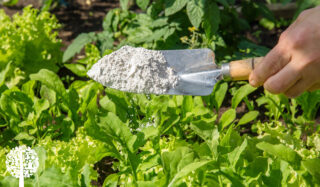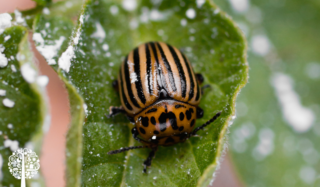Diatomaceous Earth: Should You Use It In The Garden?
It’s carnage! The Swiss chard chewed to the ground, the sprouting peas vanished, and the new shoots on the delphinium devoured. The culprits are often snails, beetles, aphids, ants, slugs, and all the tiny creatures that call the garden home. Has this happened to you during the growing season? When these critters cross a line, some gardeners turn to Diatomaceous Earth (DE) to re-establish boundaries. Others want nothing to do with it.
Everything Old Is New Again
DE is an ancient remedy. Four thousand years ago in China, people noticed birds bathing in clay dust to control mites. Mimicking the observed natural behavior, they started using DE as a pest control.

DE is a white powder made from fossilized aquatic plants called diatoms. But don’t let the smooth chalky texture fool you. These tiny skeletal pieces are sharp, and small insects suffer miniature razor blade cuts when they cross them. If ingested, the powder will dry out their mucous membranes. So it’s no wonder that insects stay away from gardens containing DE.
How To Use DE
You should wear gloves, goggles, and a dust mask to prevent breathing in the particulates when using DE.
When purchasing DE, buy “Food Grade” soil and not the kind used for swimming pool filters, which has been processed differently and has a high silica content that is dangerous to the environment.
The best time to apply DE is on a dry day by sprinkling it directly on the ground around plants. Many gardeners recommend using it wet to avoid airborne dust particles.
Mix 473 milliliters of DE with four liters of water, and spray after a light rain or early morning when the dew is upon the foliage. The moisture will help the powder adhere to the plant.
Advantages
DE is safe for humans and non-toxic for pets. Food grade DE is sometimes used as a dietary supplement to help maintain the digestive tract, but only under stringent guidelines, so don’t try this without consulting a doctor.

Containing trace amounts of magnesium, iron, and calcium, DE is beneficial to the soil, increasing drainage and breathability and is often added to container plants to prevent root rot and stagnation.
It can absorb and slowly release fertilizers, making it a fantastic addition to bonsai potting mixes.
Since DE works physically on the bodies of insects, there’s no opportunity for them to develop a resistance to its effects as they can with other synthetically produced insecticides.
Disadvantages
Bugs must come into direct and prolonged contact with DE to be effective, so it will take time before the veggie garden snacking ceases.

Unfortunately, DE is easy to misapply and may contaminate non-targeted surfaces.
Whether or not it’s genuinely effective against slugs and snails is debated, but there’s no question it’s non-discriminatory and can do a lot of harm to the beneficial insects in the garden, like spiders.
And yes, there is a possibility it can hurt bees. Only apply DE on plants where you haven’t observed any bee activity. Like the other insects in the garden, they can inhale and be cut by DE, and right now, the bees need all the help they can get.
So, there you have it – the good, bad, and ugly of DE. Now you can make an informed decision on whether it’s right for your garden.




